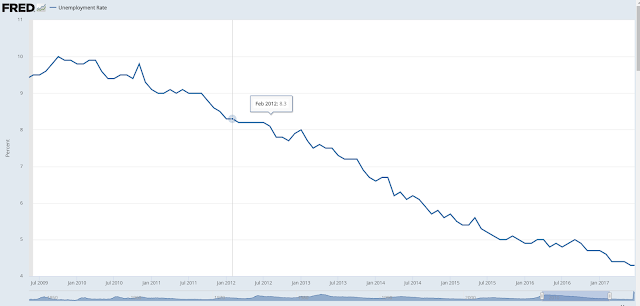Employment and unemployment:
- Unemployment: to be actively seeking job opportunities but unable to find work.
- Employment: to have a paid job, either part time or full time.
- Unemployment rate:
- Labor force: population of a nation that are either employed or unemployed (i.e seeking to work).
- Unemployment increases during recessions and falls during expansionary phases of the business cycle.
- Example:
- This graph represents the unemployment rate from 2008-2010. The shaded area indicates a period of recession, notice how sharply the unemployment rate increases over that period, the rate almost doubles.
- Look how over a period of economic expansion (2010-2017), the unemployment falls. It is even lower than at the start of the economic crisis in 2007.
- The unemployment rate is a very important (though not perfect) economic indicator, as it shows a degree of how a society is using its available resources.
Shortcomings of the unemployment rate as an economic indicator:
- discouraged workers, workers who haven't been able to find jobs in a long time, and have given up the search for work are not included.
- Because this category of people are not included, the unemployment rate can understate the negative impact of a long term economic contraction.
- Labor force participation rate decreases during a recession. The more the labor force participation rate declines, the more the unemployment rate underestimates the true level of unemployment.
Types of unemployment:
- Frictional unemployment: people moving from one job to another, or are seeking their first job but have employable skills.
- The period in between one job and another, a worker is fictionally unemployed because workers and firms for which they are a good fit have yet to find one another.
- Frictional unemployment is considered natural unemployment, because people feel like they can quit a job and go look for a better one. Job seekers have skills that are in demand.
- Structural unemployment: workers become structurally unemployed when they lose their jobs due to a changing structure of the economy (i.e their skills are no longer in demand).
- Workers who are structurally unemployed are more likely to remain unemployed for a longer period of time than those who are fictionally unemployed.
- methods to reduce structural unemployment include re-training of unemployed workers, better education, and wage flexibility.
- Just like frictional unemployment, structural unemployment is considered natural unemployment. This is due to the fact that structural unemployment can be a sign that in an economy, the productivity and overall output are growing.
- Cyclical unemployment: caused by a fall in the demand for a nation's output. It is associated with the contraction phase of the economy.
- This is not considered natural unemployment, since an individual posses the skills demanded in the economy, but the overall demand is low and thus cannot find a job.
- methods to reduce cyclical unemployment includes: reducing taxes to increase households consumption, increasing government spending, lowering interest rates to increase the level of investments by firms, and depreciating the nation's currency to increase exports.
Natural rate of unemployment (NRU):
- The NRU level of unemployment is achieved when the economy is producing at its full employment level.
- An economy producing at full employment level is only experiencing structural and frictional unemployment.
- The NRU is considered to be stable for a nation at a specific point in time. However it can vary from nation to nation and over time.
- Anything that reduces long term level of structural unemployment will reduce the nation's NRU.
The costs of unemployment:
- Individual consequences of unemployment:
- It decreases household income and purchasing power, thereby reducing the standard of living.
- It increases the level of psychological and physical illnesses.
- Social consequences of unemployment:
- Downward pressure on wages for the employed caused by the large pool of unemployed workers looking to work.
- It increases poverty and crime.
- Economic consequences of unemployment:
- Lower level of aggregate demand, the unemployed consume less, causing more workers to lose their jobs.
- Under-utilization of a nation's output. The gap between a nation's actual output and potential output, which in turns means less income for the average household.
- Increased in budget deficits. Less tax revenues, while the government increases its public expenditure (unemployment insurance, food stamps, etc...) to support the unemployed.
References:
- Welker, Jason. AP Maroeconomics Crash Course. Research & Education Association (2014). p 93-104
- Graphs: unemployment -Fed St Louis-


Comments
Post a Comment